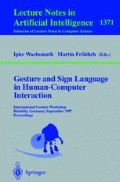Abstract
Gesture today remains a sideline in computer interfaces. I argue that this is due to several longstanding deficiencies in the theoretical foundations of the field. We must act to correct these deficiencies and strengthen the research community in order to avoid becoming a footnote in the history of computer science. I specify fundamental unsolved problems in the areas of naturalness, anthropology and systems building. I also suggest some things that we could do to make our research community stronger and more able to tackle these problems.
Preview
Unable to display preview. Download preview PDF.
References
Bolt, R. A. (1980) „Put-That-There: Voice and Gesture at the Graphics Interface“. Proceedings of SIGGRAPH’80. ACM Press, New York.
Bolt, R. A. and Herranz, E. J. (1992) „Two-handed Gesture with Speech in Multi-Modal Natural Dialogue“. Proceedings of UIST’92. ACM Press, New York.
Efron, D. (1941) Gesture and Environments. King’s Crown Press, Morningside Heights, New York.
Kendon, A. (1986) „Current Issues in the Study of Gestures.“ The Biological Foundations of Gestures: Motor and Semiotic Aspects, Nespoulous, Perron, and Lecours (eds.) Lawrence Erlbaum Associates, Hillsday, N. J.
Lakoff, G. and Johnson, M. (1980) Metaphors We Live By. University of Chicago Press, Chicago.
McNeill, D. (1992) Hand and Mind: What Gestures Reveal about Thought. University of Chicago Press, Chicago.
Murakami, K. and Taguchi, H. (1991) „Gesture Recognition Using Recurrent Neural Networks.“ Proceedings of CHI’91. ACM Press, New York.
Vaananen, K & Bohm, K. (1993) „Gesture-Driven Interaction as a Human Factor in Virtual Environments.“ Virtual Reality Systems, Gigante, M. A. & Jones, H. (eds.), Academic Press Ltd., London, UK.
Wexelblat, A. (1994) A Feature-Based Approach to Continuous-Gesture Analysis. S. M. Thesis, MIT Program in Media Arts & Sciences.
Wexelblat, A. (1995) Analysis of Natural Gestures at the User Interface, ACM Transactions on Computer-Human Interaction (ToCHI), September, 1995.
Author information
Authors and Affiliations
Editor information
Rights and permissions
Copyright information
© 1998 Springer-Verlag
About this paper
Cite this paper
Wexelblat, A. (1998). Research challenges in gesture: Open issues and unsolved problems. In: Wachsmuth, I., Fröhlich, M. (eds) Gesture and Sign Language in Human-Computer Interaction. GW 1997. Lecture Notes in Computer Science, vol 1371. Springer, Berlin, Heidelberg. https://doi.org/10.1007/BFb0052984
Download citation
DOI: https://doi.org/10.1007/BFb0052984
Published:
Publisher Name: Springer, Berlin, Heidelberg
Print ISBN: 978-3-540-64424-8
Online ISBN: 978-3-540-69782-4
eBook Packages: Springer Book Archive

